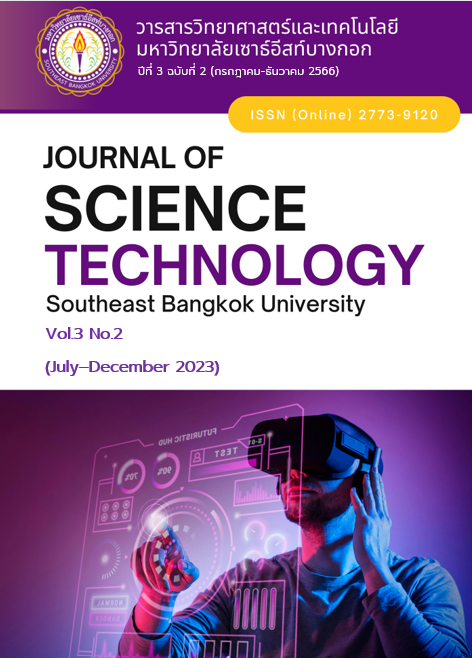การประยุกต์ใช้ GIS Analysis และ VRP วิเคราะห์ตรวจสอบข้อมูลเส้นทาง การขนส่งห่วงโซ่ความเย็น สำหรับส่งมอบวัคซีนไปยังโรงพยาบาลและศูนย์บริการสาธารณสุขในสังกัดกรุงเทพมาหานคร บทความวิจัย
Main Article Content
บทคัดย่อ
การวิจัยนี้มีวัตถุประสงค์หลักในการพัฒนาการขนส่งห่วงโซ่ความเย็นของวัคซีนเพื่อรักษาคุณภาพของผลิตภัณฑ์ โดยใช้เทคโนโลยีดิจิทัลและนวัตกรรมด้านการขนส่ง เพื่อควบคุมอุณหภูมิและจัดส่งในระยะเวลาที่สั้น โดยการใช้เครื่องมือและเทคโนโลยีต่างๆ ในการวิจัย เช่นการใช้ระบบสารสนเทศทางภูมิศาสตร์ Geographic Information System Analysis (GIS Analysis) และ Vehicle routing problem (VRP) โดยทำการศึกษาและวิเคราะห์ข้อมูลต่างๆ เพื่อหาวิธีการเชิงพื้นที่และเส้นทางการขนส่งที่เหมาะสมที่สุดสำหรับวัคซีนเพื่อลดระยะทางและเวลาในการจัดส่ง โดยจุดประสงค์หลักคือเพื่อเพิ่มประสิทธิภาพในการบริหารจัดการวัคซีนและการขนส่ง รวมถึงรักษาคุณภาพของวัคซีนในระหว่างการขนส่ง Cold chain management กลุ่มตัวอย่าง ได้แก่ตำแหน่งโรงพยาบาลและศูนย์บริการสาธารณสุข ในสังกัดกรุงเทพมาหานครจำนวน 76 จุดผลการวิจัยพบว่าการวิเคราะห์พื้นที่และการใช้ Vehicle routing problem สามารถช่วยให้สามารถสรุปแนะแนวทางและตำแหน่งที่เหมาะสมในการตั้งศูนย์กระจายวัคซีนได้อย่างมีประสิทธิภาพ ที่จะทำให้การบริหารจัดการวัคซีนและการขนส่งเป็นไปอย่างเป็นระบบและมีประสิทธิภาพมากยิ่งขึ้น การวิเคราะห์พื้นที่ช่วยในการระบุตำแหน่งที่สอดคล้องกับความต้องการในการกระจายวัคซีน และ Vehicle routing problem ช่วยในการคำนวนเส้นทางที่ทำให้การขนส่งลดเวลาและระยะทางในการขนส่ง ผลการวิจัยช่วยสนับสนุนการตัดสินใจบริหารจัดการการขนส่งห่วงโซ่ความเย็น ให้มีประสิทธิภาพมากยิ่งขึ้น สามารถควบคุมอุณหภูมิของการเก็บ รักษาวัคซีนได้ตลอดระยะทางในการขนส่งไปยังจุดส่งมอบแต่ละพิกัด
Article Details

อนุญาตภายใต้เงื่อนไข Creative Commons Attribution-NonCommercial-NoDerivatives 4.0 International License.
บทความที่ได้รับการตีพิมพ์และเป็นลิขสิทธิ์ของวารสารวิทยาศาสตร์และเทคโนโลยี มหาวิทยาลัยเซาธ์อีสท์บางกอก
เอกสารอ้างอิง
L. J. Dominguez, N. Veronese, F. Guerrero-Romero, and M. Barbagallo, "Magnesium in infectious diseases in older people," Nutrients, vol. 13, no. 1, p. 180, 2021.
T. J. Michiels et al., "Degradomics-based analysis of tetanus toxoids as a quality control assay," Vaccines, vol. 8, no. 4, p. 712, 2020.
U. Kartoglu and J. Milstien, "Tools and approaches to ensure quality of vaccines throughout the cold chain," Expert review of vaccines, vol. 13, no. 7, pp. 843-854, 2014.
R. Satria and M. Castro, "GIS tools for analyzing accidents and road design: a review," Transportation research procedia, vol. 18, pp. 242-247, 2016.
N. Shamsi Gamchi, S. A. Torabi, and F. Jolai, "A novel vehicle routing problem for vaccine distribution using SIR epidemic model," Or Spectrum, vol. 43, no. 1, pp. 155-188, 2021.
S. Krzysztofowicz and K. Osińska-Skotak, "The use of GIS technology to optimize COVID-19 vaccine distribution: a case study of the city of Warsaw, Poland," International Journal of Environmental Research and Public Health, vol. 18, no. 11, p. 5636, 2021.
A. L. Achu, C. D. Aju, V. Suresh, T. P. Manoharan, and R. Reghunath, "Spatio-Temporal Analysis of Road Accident Incidents and Delineation of Hotspots Using Geospatial Tools in Thrissur District, Kerala, India," KN - Journal of Cartography and Geographic Information, vol. 69, no. 4, pp. 255-265, 2019.
I. R. Cleasby, E. Owen, L. Wilson, E. D. Wakefield, P. O'Connell, and M. Bolton, "Identifying important at-sea areas for seabirds using species distribution models and hotspot mapping," Biological Conservation, vol. 241, p. 108375, 2020.
Y. Yang and J. Rajgopal, "Outreach strategies for vaccine distribution: a multi-period stochastic modeling approach," Operations Research Forum, vol. 2, no. 2,p. 24, 2021.
S. Sripada, A. Jain, P. Ramamoorthy, and V. Ramamohan, "A decision support framework for optimal vaccine distribution across a multi-tier cold chain network," Computers & Industrial Engineering, vol 182,p. 109397, 2023.
Z. Wen et al., "Cold chain logistics management of medicine with an integrated multi-criteria decision-making method," International journal of environmental research and public health, vol. 16, no. 23, p. 4843, 2019.
B. Malmir and C. W. Zobel, "A Robust Optimization Approach to a Real Humanitarian Cold Supply Chain Planning on the COVID-19 crisis," [Online].
Available:https://arxiv.org/ftp/arxiv/papers/2208/2208.13256.pdf. [Accessed: Feb. 27, 2022].
K. D. Alemdar, Ö. Kaya, M. Y. Çodur, T. Campisi, and G. Tesoriere, "Accessibility of vaccination centers in COVID-19 outbreak control: A gis-based multi-criteria decision making approach," ISPRS International Journal of Geo-Information, vol. 10, no. 10, p. 708, 2021.
K. Faisal et al., "Spatial Analysis of COVID-19 Vaccine Centers Distribution: A Case Study of the City of Jeddah, Saudi Arabia," International Journal of Environmental Research and Public Health, vol. 19, no. 6, p. 3526, 2022.
R. Yu, L. Yun, C. Chen, Y. Tang, H. Fan, and Y. Qin, "Vehicle Routing Optimization for Vaccine Distribution Considering Reducing Energy Consumption," Sustainability, vol. 15, no. 2, p. 1252, 2023.
K. Izikki, J. El Alami, and M. Hlyal, "The use of the internet of things in the cold chain logistics for a better vaccine transportation: A state of the art," the 4th International Conference on Innovative Research in Science Engineering and Technology, Milan, Italy, pp. 7-9, 2021.
K.-S. Lee, "Disparity in the spatial distribution of clinics within a metropolitan city," Geospatial Health, vol. 7, no. 2, pp. 199-207, 2013.


